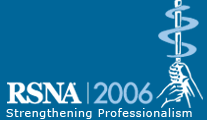
Abstract Archives of the RSNA, 2006
LL-NM2091-H06
Absorbed Dose from Daily Routine Practice in an 18F-FDG Producing Radiopharmacy
Scientific Posters
Presented on November 28, 2006
Presented as part of LLNM-H: Nuclear Medicine
Giovanni Tosi PhD, Presenter: Nothing to Disclose
Katia Marzo, Abstract Co-Author: Nothing to Disclose
Arturo Chiti MD, Abstract Co-Author: Nothing to Disclose
To evaluate the average daily exposure to ionizing radiations from fluorine-18 of workers in a radiopharmacy laboratory producing 18f-fluoro-deoxy-glucose for clinical activity
We used portable electronic dosimeters MGP-DMC 2000s to evaluate effective and equivalent doses. These instruments can measure doses (Hp(10)) and dose rates due to photon with energies ranging from 50 keV to 3 MeV, with a confidence interval lower than 20%. An electronic dosimeter was placed on the chest of one operator, to estimate effective and superficial dose on a daily basis. The measure were taken during 48 working days over a time period of 3 months, in which 90 18F-FDG synthesis were performed.
The daily routine production requires setting up two 18F-FDG synthesis modules (one module for each synthesis); 18F-FDG quality controls for chemical, radiochemical and radionuclide purity, and residual solvents. The mean end of synthesis 18F-FDG activity was 21.6 GBq. Moreover the fractionating of an average of 17 patient’s doses was operated using an automatic system.
The mean daily effective dose during the observation period was 5±3 μSv (range 1-13 μSv) while the superficial dose was 11±6 μSv (range 2-32 μSv).
From this data we speculate the highest contribution to the operator’s effective dose is related to the setup of the synthesis module, which is still active after about 20 hours from the previous synthesis.
No significant dose is due to dose fractionating, thanks to the use of an automatic system
We concluded effective doses to the operators are well below the accepted limits (20 mSv/year) and an improvement can be achieved reducing the time required for the synthesis module setup.
Exposure due to 18F-FDG synthesis is due to module setup and can be easily lowered
Tosi, G,
Marzo, K,
Chiti, A,
Absorbed Dose from Daily Routine Practice in an 18F-FDG Producing Radiopharmacy. Radiological Society of North America 2006 Scientific Assembly and Annual Meeting, November 26 - December 1, 2006 ,Chicago IL.
http://archive.rsna.org/2006/4436919.html

